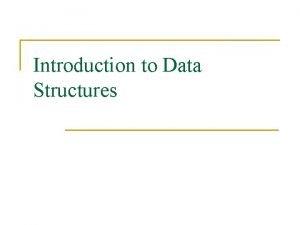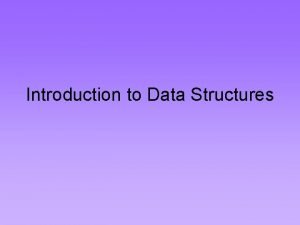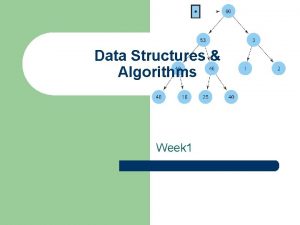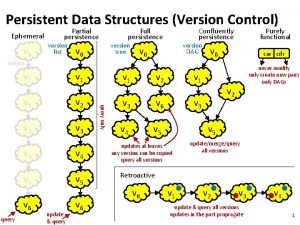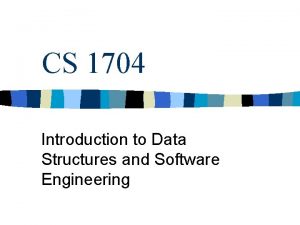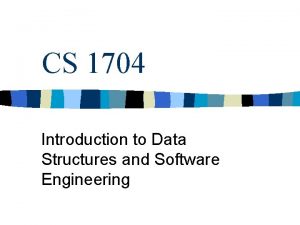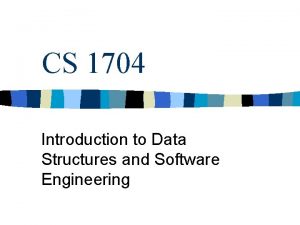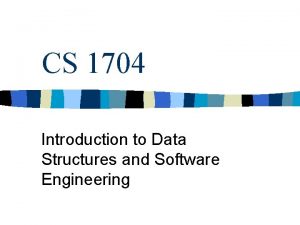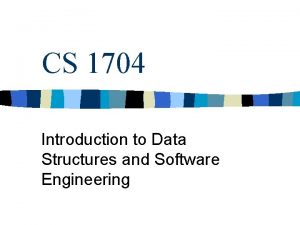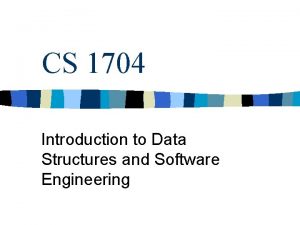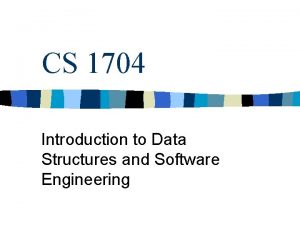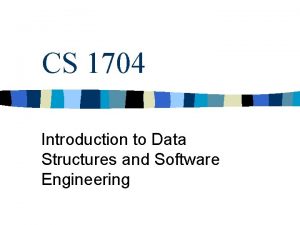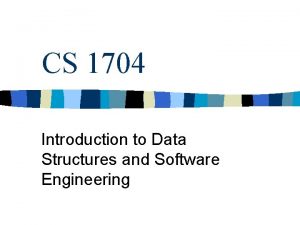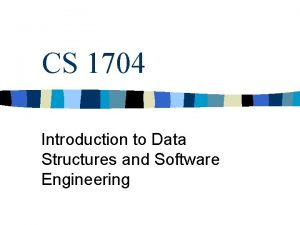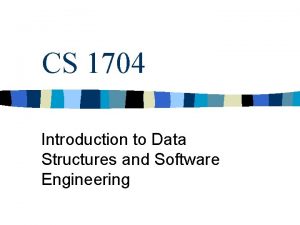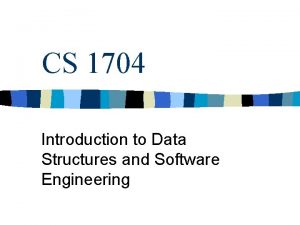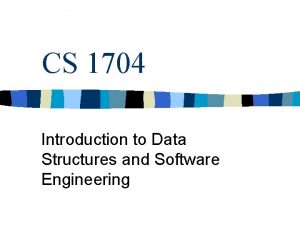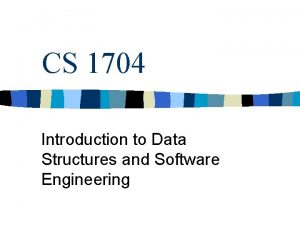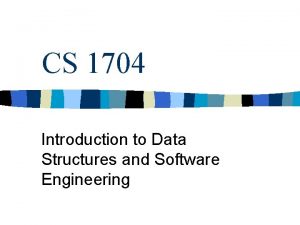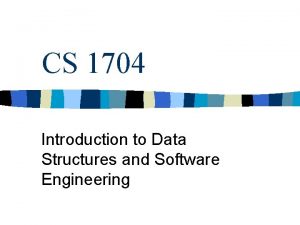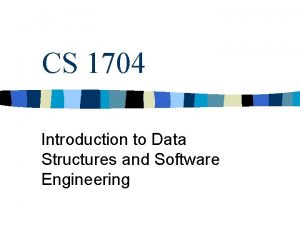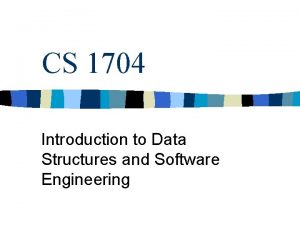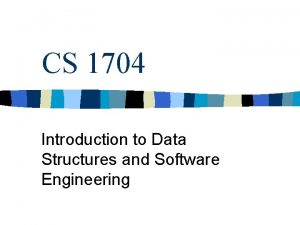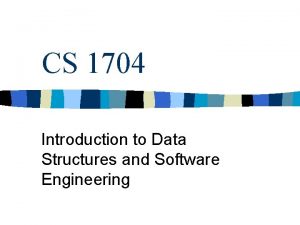CS 1704 Introduction to Data Structures and Software






















- Slides: 22

CS 1704 Introduction to Data Structures and Software Engineering

Recursion n. A process in which the result of each repetition is dependent upon the result of the next repetition

Recursive Version int Factorial(int n ) { if ( n > 1 ) return( n * Factorial (n-1) ); else return(1); }


Recursion n Every recursive algorithm can be implemented non-recursively. – recursion <==> iteration Eventually, the routine must not call itself, allowing the code to "back out". n Recursive routines that call themselves continuously are termed: n – infinite recursion <==> infinite loop Problem with recursive factorial implementation? Negative numbers! n Recursion is inefficient at runtime. n

Coding Recursion n Solve the trivial "base" case(s). n Restate general case in 'simpler' or 'smaller' terms of itself. – Divide and Conquer n List Example – Determine the size of a single linked list. • Base Case : Empty List, size = 0 • General Case : 1 + Size(Rest of List)

Types of Recursion n Tail recursive – functions are characterized by the recursive call being the last statement in the function, (can easily be replaced by a loop). n Head Recursive – Recursive call is the first statement (maybe after a base check) n Middle Decomposition

Recursion Underpinnings n Every instance of a function execution (call) creates an Activation Record, (frame) for the function. – Activation records hold required execution information for functions: • • • Return value for the function Pointer to activation record of calling function Return memory address, (calling instruction address) Parameter storage Local variable storage

Function Estimation If n > 10 then n 2 > 100 If n > 5 then n 2 > 5 n Therefore, if n > 10 then: f(n) = 3 n 2 + 5 n + 100 < 3 n 2 + n 2 = 5 n 2 n So 5 n^2 forms an “upper bound” on f(n) if n is 10 or larger (asymptotic bound). In other words, f(n) doesn't grow any faster than 5 n^2 “in the long run”.

Big-Oh Defined To say f(n) is O(g(n)) is to say that f(n) is “less than or equal to” Cg(n) n More formally, Let f and g be functions from the set of integers (or the set of real numbers) to the set of real numbers. Then f(x) is said to be O( g(x) ), which is read as f(x) is big-oh of g(x), if and only if there are constants C and n 0 such that | f(x) | <= C | g(x) | whenever x > n 0. n Don’t be confused … – “f(n) is of Order g(n)” n

The trick N(N + 1)/2 + N 2 ank + bnk-1 + … + yn + z ank nk

Some complexity classes … Constant O(1) Logarithmic O(log n) Linear O(n) Quadratic O(n 2) Cubic O(n 3) Polynomial O(np) Exponential O(an)


Does it matter? Let n = 1, 000, & 1 ms / operation. n = 1000, 1 ms/op n 1 second n log 2 n 10 seconds n 2 17 minutes n 3 12 days n 4 32 years n 10 3. 17 1019 years 2 n 1. 07 10301 years max n in one day 86, 400, 000 3, 943, 234 9, 295 442 96 6 26

Practical Curves n log n n 2 n log n

Best Case Analysis n Assumes the input, data etc. are arranged in the most advantageous order for the algorithm, i. e. causes the execution of the fewest number of instructions. – E. g. , sorting - list is already sorted; searching - desired item is located at first accessed position.

Worst Case Analysis n Assumes the input, data etc. are arranged in the most disadvantageous order for the algorithm, i. e. causes the execution of the largest number of statements. – E. g. , sorting - list is in opposite order; searching - desired item is located at the last accessed position or is missing.

Average Case Analysis n Determines the average of the running times over all possible permutations of the input data. – E. g. , searching - desired item is located at every position, for each search), or is missing.

Sorting Terms & Definitions Internal sorts holds all data in RAM n External sorts use Files n Ascending Order: n – Low to High n Descending Order: – High to Low n Stable Sort – Maintains the relative order of equal elements, in situ. – Desirable if list is almost sorted or if items with equal values are to also be ordered on a secondary field.

Sorting Thoughts n Comparison-Based Sorting – Algorithms which compare element values to each other – What is the minimum number of comparisons, required to sort N elements using a comparison-based sort? n Is a Queue a type of sorting?

N log N Since the depth of all leaf nodes is > log 2 N! in a comparison tree, the minimal number of comparisons to sort a specific initial ordering of N elements is > log 2 N! n Stirling’s Approximation for log 2(N!) can be used to determine a lower bound for log 2(N!) which is O(N log N ) n No comparison based sorting algorithm can sort faster than n – O(N log N)

Both Sorting & Searching n Know what each algorithm does n How it works n Big Oh analysis of each
 Poolse koning 1704
Poolse koning 1704 Strp manulife
Strp manulife Homologous
Homologous Introduction to data structures
Introduction to data structures Introduction to data structures
Introduction to data structures Introduction to data warehouse
Introduction to data warehouse Ajit diwan
Ajit diwan Kevin wayne princeton
Kevin wayne princeton Data structures and algorithms tutorial
Data structures and algorithms tutorial Conditional macro expansion in system software
Conditional macro expansion in system software Assembler algorithm and data structures
Assembler algorithm and data structures Information retrieval data structures and algorithms
Information retrieval data structures and algorithms Data structures and abstractions with java
Data structures and abstractions with java Data structures and algorithms bits pilani
Data structures and algorithms bits pilani Adts, data structures, and problem solving with c++
Adts, data structures, and problem solving with c++ Ajit diwan
Ajit diwan Data structures and algorithm
Data structures and algorithm Data structures and algorithms
Data structures and algorithms Data structures and algorithms
Data structures and algorithms Waterloo data structures and algorithms
Waterloo data structures and algorithms Information retrieval data structures and algorithms
Information retrieval data structures and algorithms Ephemeral data structure
Ephemeral data structure Data structures and algorithms
Data structures and algorithms



